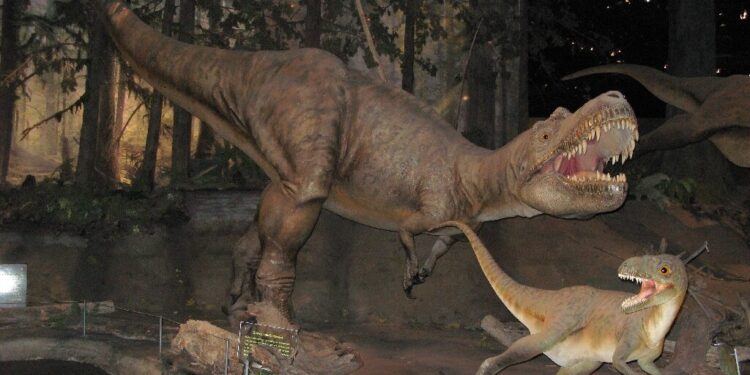Gorgosaurus is part of the Tyrannosaurus family which also includes the T-Rex.
Prey has been discovered for the first time in the stomach of a Tyrannosaurus skeleton, scientists announced Friday, revealing that the mighty dinosaurs had an “appetite for drumsticks” when they were young.
The skeleton of Gorgosaurus, a member of the Tyrannosaurus family that also includes the T-Rex, sheds light on how these dinosaurs evolved from fairly slender juveniles to gigantic, bone-crushing apex predator adults, they added. .
Gorgosaurus, meaning “terrible lizard,” was about six years old when it died more than 75 million years ago, according to a new study published in the scientific journal. Scientists progress.
The fossil was discovered in 2009 in Dinosaur Provincial Park, east of the Canadian city of Calgary. But when they brought the skeleton back to the lab, the scientists noticed something strange.
The lead author of the study, François Therrien of the Royal Tyrrell Museum, told AFP he was surprised to “discover the remains of the last meal of this young tyrannosaur still preserved in place”.
What was most surprising, he added, was that the small leg bones protruding from the tyrannosaur’s ribcage belonged to two young bird-like dinosaurs called Citipes.
Citipes are thought to have feathers, wings and a beak and walked on two legs, somewhat resembling modern-day cassowaries, Therrien said.
They are much smaller than the huge herbivorous dinosaurs that adult tyrannosaurs ate.
Darla Zelenitsky, co-author of the study and paleontologist at the University of Calgary, told AFP that this “picky eater” used its sharp teeth to carve only the legs of the two baby Citipes.
“This adolescent Gorgosaurus seems to have an appetite for drumsticks,” she said.
Not always an apex predator
The discovery also offers a rare clue to how tyrannosaurs grew from one meter long at birth to some of the largest predators to ever walk the Earth.
“This fossil is the first solid evidence that tyrannosaurids dramatically changed their diet as they moved from adolescence to adulthood,” Zelenitsky said.
Young tyrannosaurs had slender heads and legs, sharp knife-like teeth for dissecting carcasses, and could probably run fast enough to catch their turkey-like prey.
These youngsters probably looked more like the velociraptors depicted in the movie “Jurassic Park” than the giant T-Rex, Zelenitsky said.
But by around age 11, as tyrannosaurs reached middle age, their bodies grew almost ten times larger, eventually weighing more than 3,000 kilograms (6,600 pounds).
Their heads enlarged and their teeth thickened into what Therrien called “killer bananas,” capable of crunching enormous bones.
This transformation was driven by a change in diet, as dinosaurs abandoned the drumsticks of their youth and began preying on giant herbivorous dinosaurs.
These kinds of drastic dietary changes aren’t necessarily uncommon in the animal kingdom: Crocodiles and Komodo dragons start out eating insects before moving on to rodents and eventually large mammals, Therrien said.
Researchers said the Gorgosaurus fossil supports the theory that young tyrannosaurs, including the T-Rex, played a role in the food chain known as “mesopredators”, before later becoming predators in summit.
This change is “probably why tyrannosaurs were so successful and dominated their ecosystems during the late Cretaceous in North America and Asia,” Therrien said.
More information:
François Therrien et al, The exceptionally preserved stomach contents of a young tyrannosaurid reveal an ontogenic diet shift in an extinct iconic predator, Scientists progress (2023). DOI: 10.1126/sciadv.adi0505
© 2023 AFP
Quote: ‘Appetite for drumsticks’: First prey found in the stomach of a tyrannosaurus (December 8, 2023) retrieved December 9, 2023 from
This document is subject to copyright. Except for fair use for private study or research purposes, no part may be reproduced without written permission. The content is provided for information only.



